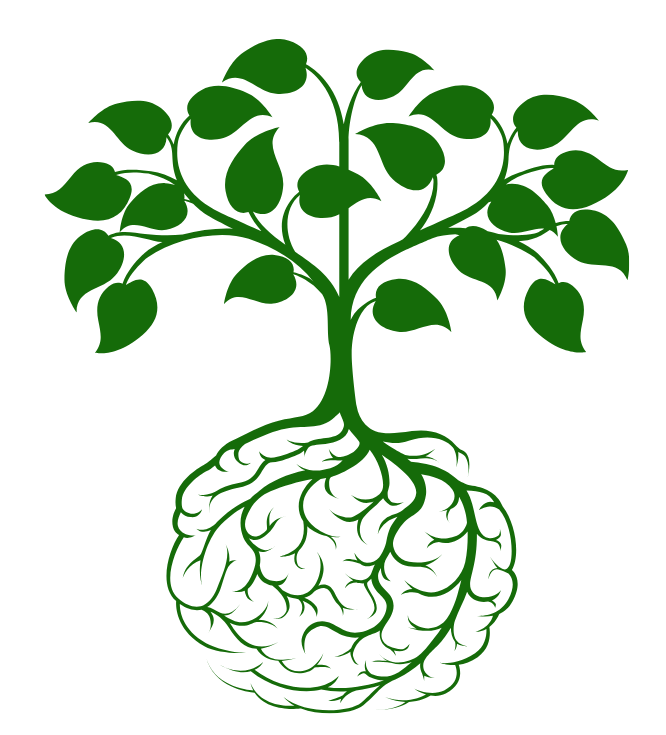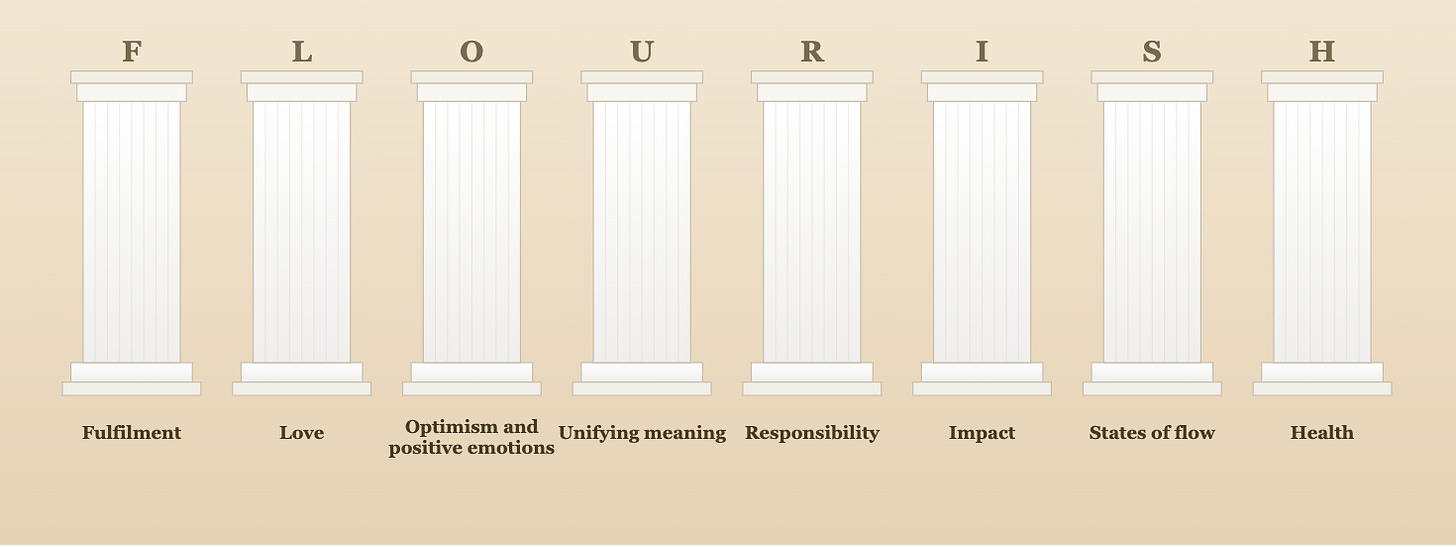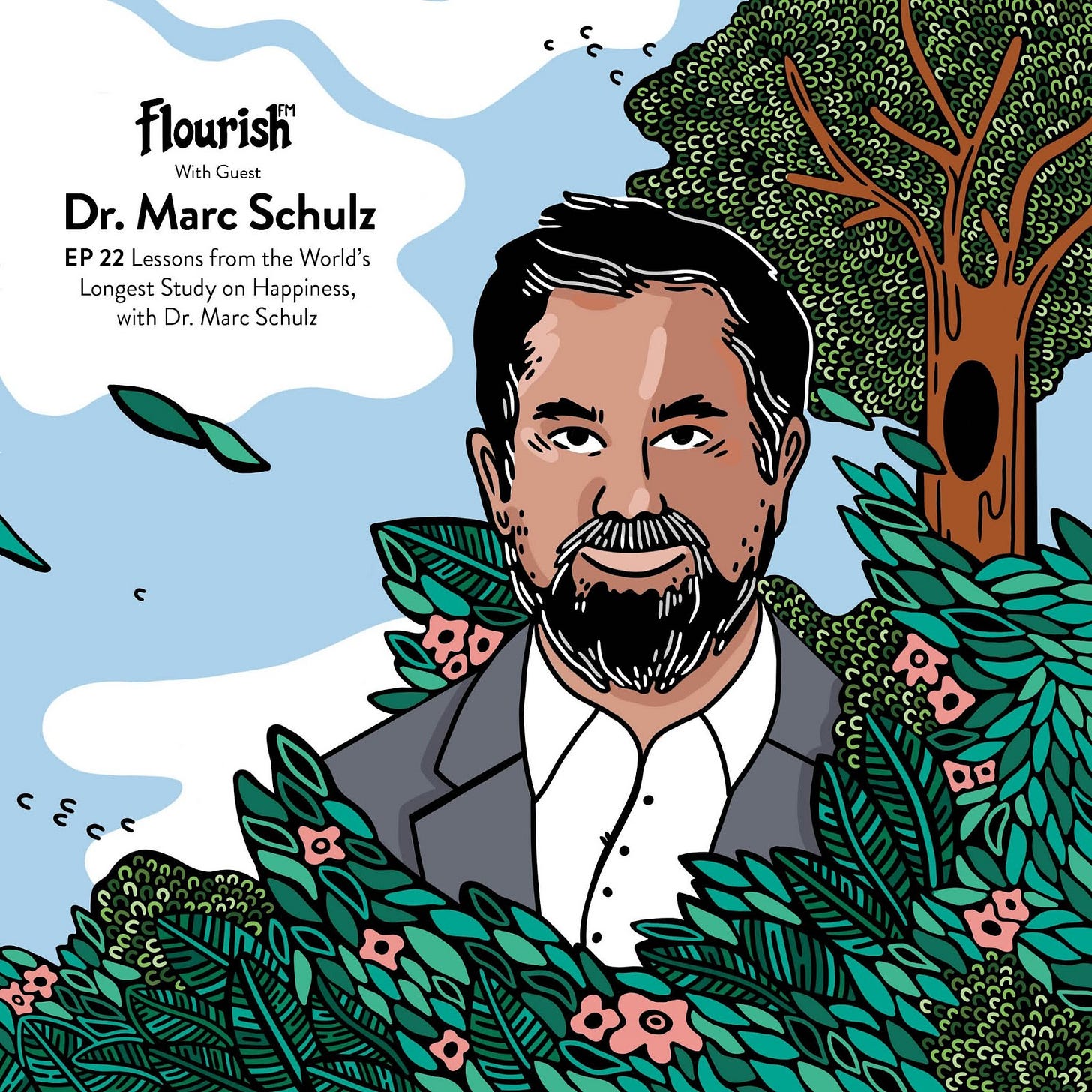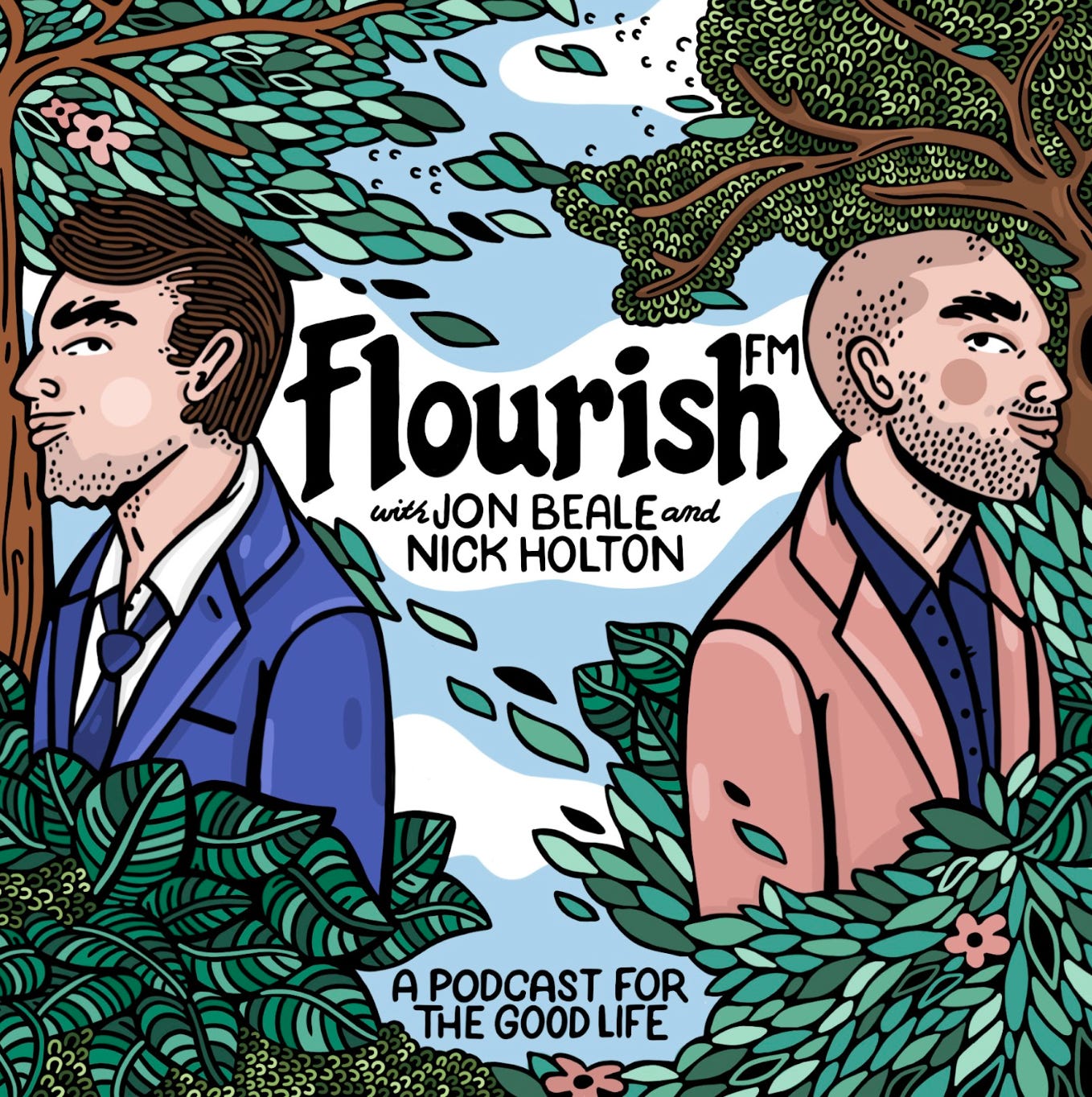How to Flourish: The 8 Pillars of a Flourishing Life
What it takes to flourish, and how to do it
Highlights:
The eight areas of life research has identified as most important for human flourishing.
A method for promoting flourishing by improving these areas.
Watch | Listen 👇
What does it mean to flourish?
To ‘flourish’ means for a living organism to ‘grow or develop in a healthy or vigorous way, especially as a result of a particularly congenial environment’. The verb comes from the Latin word florere, meaning ‘to bloom or flower’. When a flower blooms, it reaches the peak of its development. To flourish, as human beings, is to reach our optimal development: to live the best lives we can, given our nature and relative to the environment in which we live.
To find what constitutes optimal human development, we need to identify the factors that most help us reach it. An effective way to do this is to identify factors that fulfil two criteria.
First, those that most significantly improve our well-being. These include health, happiness and strong relationships.
Second, those we pursue as ends in themselves, rather than a means to some further end. These are the ultimate goals of our activities: things we do for their own sake, just because we want to do them. We all desire lives where we have obtained these. The best life for a human being is one in which at least some of these ends have been fulfilled. All the major theories of flourishing, from Aristotle to today, aim to identify these and show us how to reach them.
To illustrate an end in itself, consider the reasons you go walking. You do so as a means to various ends: to reach a destination, exercise or simply because you enjoy walking. If you walk just because you enjoy it, a child might ask you, ‘but why do you want that?’. You could respond that doing things you enjoy makes you happier. Again, the child might ask, ‘but why do you want that?’. It’s now harder to answer, not just because the question is more difficult, but because we’ve reached the end in itself: why wouldn’t you want to be happier?
Happiness is the clearest example of something we pursue for its own sake. We don’t want happiness because it’ll help us reach some further goal; we want it simply because it’s good.
Giving a talk on flourishing on Placencia Beach, Belize, 2021
Theories of flourishing
Aristotle argued that there was only one end in itself: ‘eudaimonia’, which translates to ‘flourishing’ or ‘happiness’. Many great thinkers since have agreed. But in recent decades, researchers have identified several areas of life we pursue for their own sake, and argued that flourishing is best understood as a combination of these.
For example, positive psychology, the scientific study of flourishing, defines flourishing as optimal psychological well-being, consisting of five domains we pursue as ends in themselves which significantly improve our well-being. The Human Flourishing Program at Harvard also identifies five domains, some of which are different to those in positive psychology. Describing this theory of flourishing, Tyler VanderWeele and Tim Lomas from the Human Flourishing Program define flourishing as,
‘the relative attainment of a state in which all aspects of a person’s life are good, including the contexts in which that person lives’.
‘All aspects of life’ refers to the five domains identified in the Human Flourishing Program’s theory. ‘Contexts’ covers a person’s environment, culture and the time in which they live. For example, if a person has high well-being but lives in a conflict zone or a society in which they’re oppressed, this prevents flourishing.
The eight pillars of human flourishing
Since there are differences across theories of flourishing about the domains that constitute flourishing, an effective way to define flourishing and show how to flourish is to extract all of these areas and find a method for promoting all of them as much as possible. I do this in what follows.
In addition to the two theories of flourishing above, I’ve also looked in particular at the theories of flourishing by UNESCO and the Jubilee Centre for Character and Virtues, and the longest ever study of human life, the Harvard Study of Adult Development.
From these theories and others, we can identify eight key areas of life that most promote flourishing. Research has shown that these areas significantly improve our well-being. We generally pursue these as ends in themselves.
In what follows, I explain these eight ‘pillars of flourishing’ and describe a method for increasing flourishing by promoting each area. I discuss this research in more detail in this forthcoming book chapter.
Since ‘flourish’ has eight letters, we can use this as an acronym to represent these pillars:
F: Fulfilment
L: Love
O: Optimism and positive emotions
U: Unifying meaning
R: Responsibility
I: Impact
S: States of flow
H: Health
I summarise these in this video.
The eight pillars of human flourishing
1. Fulfilment
Fulfilment has two key senses particularly important for flourishing:
Fulfilment of potential
Fulfilment in the sense of life satisfaction
We all want to fulfil our potential. Many regard this as the most important aim of life. This is desirable, as long as we use our potential to do good things.
‘Fulfilment’ has a second sense important for flourishing: contentment with our lives. This is sometimes captured in theories of flourishing by ‘life satisfaction’ – for example, by the Human Flourishing Program at Harvard.
2. Love
This covers good and close social relationships.
Research shows that relationships have an incredibly powerful impact on our health, happiness and well-being. It’s no exaggeration to say that the strength of our relationships is the most significant predictor of our long-term happiness and well-being.
That’s been the key finding from the Harvard Study of Adult Development, which has tracked hundreds of people and their families for 87 years. It’s found that relationships are the greatest predictor of happiness, well-being and health. Strong relationships are even better at predicting whether we’ll live a happy and long life than our genes, IQ or social class.
Learn more in this blog and this conversation I had with the study’s Associate Director, Marc Schulz.
Artwork by Kelly Malka
3. Optimism and positive emotions
This encompasses happiness and other positive emotions, such as optimism, joy, laughter and gratitude. We all desire these and they significantly contribute to living a good life.
Gratitude is especially powerful. Experiencing and practising gratitude has been shown to significantly increase happiness and strengthen our relationships, and even help us live longer.
Optimism has also been shown to significantly improve our health and well-being. Optimism is also a skill we can learn. Note, though, that my labelling of this pillar ‘optimism and positive emotions’ isn’t because optimism has greater benefits than all other positive emotions; it’s simply because I needed something suitable to represent ‘O’ in the ‘FLOURISH’ acronym!
4. Unifying meaning
This covers meaning, purpose and mattering.
The first two concern the sense of meaning and purpose we find in our lives and our most important activities, such as our relationships and work. The final concerns how much we feel we matter in our roles at work and how much we feel our work matters. For example, we feel like our work makes a positive difference and we’re not easily dispensable. (I’ve called these ‘unifying’ to bring these three areas together, and to make this fit the acronym!)
‘Mattering’ has been identified as increasingly important in workplace well-being in recent years. This led to it being added to positive psychology’s theory of flourishing.
For a discussion of mattering, see this conversion I had with Zach Mercurio, author of The Power of Mattering (2025), and on mattering in positive psychology, see this conversation I had with Gabriella Kellerman, co-author of Tomorrowmind (2023) with one of the founding psychologists behind positive psychology, Martin Seligman.
Artwork by Kelly Malka
5. Responsibility
This represents good character, which we can develop by building character virtues or strengths.
This also covers building good habits which develop virtues and strengths. For example, building the habit of a strong work ethic develops the virtue of conscientiousness.
Character development is vital for various areas of flourishing, such as fulfilling our potential and reaching happiness. Most importantly, it’s vital for becoming a good person, because a good person is someone with good character virtues who uses them to promote good in the world.
Aristotle emphasised the importance of character for flourishing. Today, neo-Aristotelian theories such as that by the Jubilee Centre for Character and Virtues focus on character as the most important area of flourishing.
6. Impact
This covers meaningful accomplishments.
These range from everyday wins like giving it our all in a morning fitness class to lifetime achievements like landing our dream job. Accomplishments we find meaningful significantly improve our lives in ways important for flourishing, such as eliciting positive emotions and bringing us life satisfaction.
7. States of flow
Flow is the state of optimal attention and performance, where we completely concentrate on a challenging activity that stretches our skills to their limits. You experience flow when you’re ‘in the zone’ playing a sport or so engrossed by a book you can’t put it down. You can experience flow alone or in groups, hence there being multiple ‘states’.
Research has shown that flow has a substantial impact on areas important for flourishing: our health, happiness, sense of meaning in life, psychological well-being, and performance (for a summary, see this forthcoming book chapter of mine).
Flow is one of the five areas of well-being constituting positive psychology’s theory of flourishing. For a description of flow’s connection with flourishing, see this talk of mine.
To learn more about flow and attend free monthly masterclasses on flow, join the free platform I recently co-launched, Flow Lab.
8. Health
This covers mental and physical health, and vitality: the feeling of energy we have in our day to day lives (for example, a person suffering from flu or a hangover has low vitality).
Health is obviously vital for flourishing and is an area most people desire as an end in itself.
How to flourish by promoting each area
The most effective way to improve flourishing is to do the following (which I also explain this in this video):
build all of the eight pillars as much as you reasonably can, without your efforts to build any of them risking significantly depleting any others long-term.
For example, many people prioritise I (Impact), by working extremely hard to accomplish as much as they can. Their work is also a major source of meaning (U) and fulfilment (F) in their lives. So this supports flourishing.
However, they prioritise work so much that it takes a significant toll on their health (H) and relationships (L). Many people worldwide are lonely, chronically sleep deprived and at high risk of burnout primarily because of how much they prioritise work over everything else.
This is an example of how an excessive focus on areas of life important for flourishing depletes other important areas. A highly successful but unhealthy and lonely person isn’t flourishing.
Short-term, such actions don’t threaten a person’s flourishing: there are periods of life when we need to prioritise things that promote flourishing but have a detrimental impact on our health – for example, sleep deprivation while raising a child, or a period of high stress to achieve a meaningful work goal. But long-term, significantly depleting any of the eight areas limits the potential for flourishing. For example, chronic sleep deprivation and stress significantly negatively impact health and vitality, positive emotions, our ability to work and be present in our relationships, and so on.
This is among the reasons flourishing is a long-term state of being. People flourish for substantial periods of their lives, not for a few days or weeks.
Flourishing is relative
There isn’t an objective ‘score’ you need to reach to flourish, nor a precise balance you need to strike across all eight of the areas. People differ in terms of which of the areas they most prioritise, which is fine. There’s nothing wrong with prioritising your relationships or health over your work, or vice versa, as long as you don’t prioritise any of these so much that their prioritisation has a significant detrimental impact on any others long-term.
Validated measures on flourishing provide you with useful results, but these shouldn’t be used to conclude that there’s some precise score across some or all of the eight areas you need to reach to flourish. They are, rather, useful measures to identify which areas you should prioritise to improve your well-being, and to assess your growth over time.
I most recommend using the Flourish Measure by the Human Flourishing Program at Harvard and the PERMA measure by the UPenn Positive Psychology Center. These are both freely available online.
So there isn’t the same objective level nor the same balance across all eight areas we all need to reach to flourish. To flourish, we should aim to reach a good level relative to our condition and situation.
For example, the degree to which our health needs to be good to support flourishing is relative to our condition and situation, such as our stage of life. Many of the factors that enable an elderly person to be in good health are different from those that enable a teenager to be in good health. (It’s noteworthy that research has found that older adults report the highest level of emotional well-being of all age groups, despite their physical health generally being lowest of all age groups.)
This is among the reasons why, as we saw above, VanderWeele and Lomas of the Human Flourishing Program define flourishing as ‘the relative attainment of a state in which all aspects of a person’s life are good’.
The Takeaway
From research on flourishing we can identify eight key areas of life that most support flourishing. These I call the eight ‘pillars of flourishing’:
F: Fulfilment
L: Love
O: Optimism and positive emotions
U: Unifying meaning
R: Responsibility
I: Impact
S: States of flow
H: Health
I would define flourishing as:
A long-term state of being in which each of these pillars is strong, relative to an individual and their environment.
I use ‘environment’ to cover the time, place and situation in which one lives.
The most effective way to promote flourishing is to build all of the pillars as much as you reasonably can, without your efforts to build any of them risking significantly depleting any others long-term.
Try to do this, but watch out for where your efforts to build any area risk significantly depleting any of the others. When there is this risk, reassess your approach, looking for ways to continue building each area while avoiding this risk.
drjonbeale.com | @drjonbeale
Recommended resources
Books:
Aristotle, Nicomachean Ethics [c. 350 BCE], translated by W. D. Ross, revised by J. O. Urmson, in The Complete Works of Aristotle, Revised Oxford Translation, Vol. 2, edited by Jonathan Barnes (Princeton University Press, 1984)
Aristotle, Eudemian Ethics, edited & translated by Anthony Kenny (Oxford University Press, 2011)
Mihaly Csikszentmihalyi, Flow: The Classic Work on How to Achieve Happiness (Rider, 2002 [1990])
Kristján Kristjánsson, Flourishing as the Aim of Education: A Neo-Aristotelian View (Routledge, 2020)
Richard Layard, Happiness: Lessons from a New Science (Penguin, 2011 [2005])
Christopher Peterson & Martin Seligman, Character Strengths and Virtues (Oxford University Press, 2004)
Gabriella Kellerman and Martin Seligman, Tomorrowmind: Thrive at Work with Resilience, Creativity and Connection, Now and in an Uncertain Future (Atria Books, 2023)
Martin Seligman, Flourish: A Visionary New Understanding of Happiness and Well-being (Simon and Schuster, 2011)
Robert Waldinger & and Marc Schulz, The Good Life and How to Live It: Lessons from the World’s Longest Study on Happiness (Simon and Schuster, 2023)
Peer-reviewed articles:
Tim Lomas & Tyler VanderWeele, ‘The Garden and the Orchestra: Generative Metaphors for Conceptualizing the Complexities of Well-Being’, International Journal of Environmental Research and Public Health 19: 21: 14544 (2022)
Jacolyn Norrish et al., ‘An Applied Framework for Positive Education’, International Journal of Wellbeing 3 (2013)
Martin Seligman & Mihaly Csikszentmihalyi, ‘Positive Psychology: An Introduction’, American Psychologist, January 2000
Tyler VanderWeele, ‘On the Promotion of Human Flourishing’, Proceedings of the American Academy of Sciences, 31 (2017)
Tyler VanderWeele & Tim Lomas, ‘Terminology and the Well-being Literature’, Affective Science (2022)
Peer-reviewed book chapters:
Jon Beale, ‘What Role Should Human Flourishing Play Among Education’s Aims?’, in Jon Beale & Christina Easton (eds.), The Future of Education: Reimagining Its Aims and Responsibilities (Oxford University Press, 2025)
White papers and research briefs:
Doret de Ruyter et al., ‘Meaning(s) of Human Flourishing and Education: A Research Brief by the ISEE Assessment’ (UNESCO, 2020).
Jubilee Centre, Framework for Character Education in Schools, (Third Edition, 2022 [2017]).
Podcasts:
Flourish FM: a podcast for the good life (referenced above: episodes with Marc Schulz, Gabriella Kellerman and Zach Mercurio)







